The peacock plant (Calathea Makoyana) is an eye-catching houseplant that’s native to Brazil.
It gets its name from its leaves having feathery patterns much like a peacock’s tail.
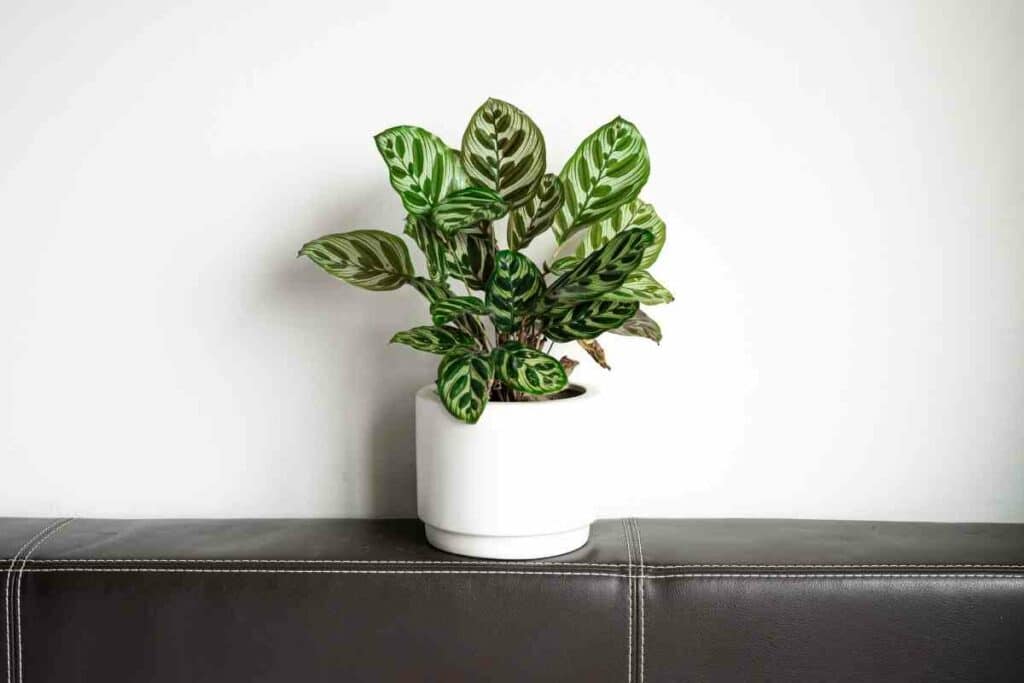
With needs all met, the peacock plant adds a beautiful energy and color to the home.
In this article, we’ll tell you all about how to care for your peacock plant so that you can keep it healthy and beautiful.
Before We Start
There are many Calathea traits like the waxy texture and green outlines.
However, the makoyana presents itself with leaves that are a maroon-purple underneath.
When they’re rolled up, young leaves are all this color and only develop their greenness when they spread out and mature.
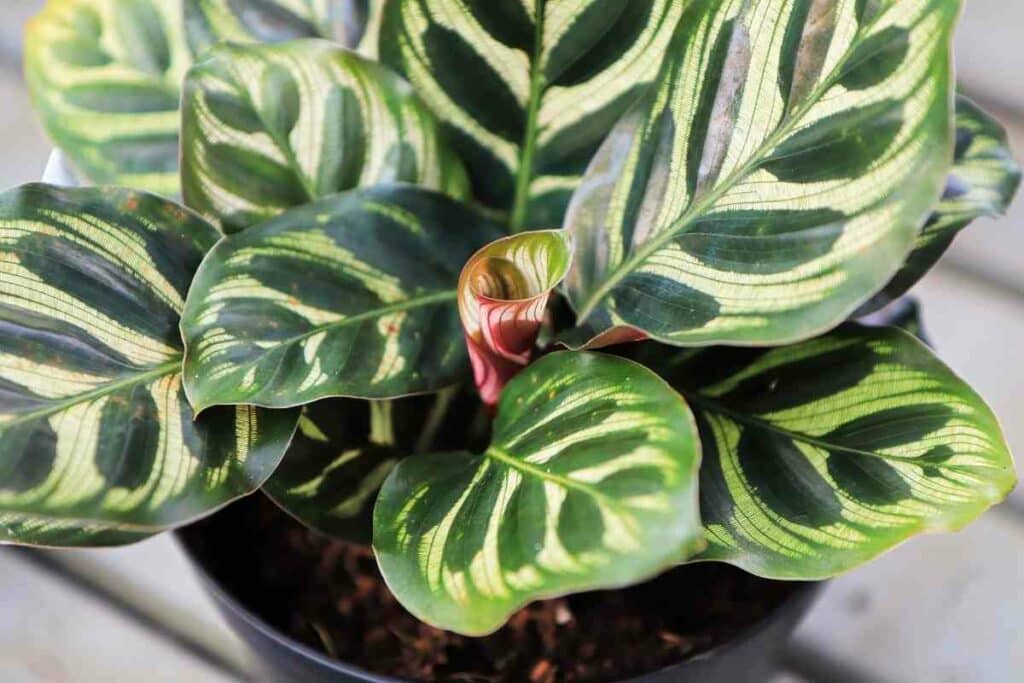
Since these plants are non-toxic, they’re a popular addition in homes where pets and children are present.
Because of its roots in the tropics, the peacock plant has specific needs in terms of its care.
In Eastern Brazil where the plant is native, it would grow in damp and dark conditions of the rainforest understory.
This means that homeowners need to replicate the natural environment as much as possible.
Peacock plant basic care
If you’re looking for a quick answer, here are some of the basic care needs of a peacock plant:
- Keep it in a space where humidity is above 60% and temperatures are between 60 °F and 75 °F.
- Grow your plant in a pot with potting soil mixed with peat moss and use perlite or pumice for drainage.
- Place the plant where it can catch indirect sunlight.
- Water it twice a week so the soil stays moist.
- From spring through to summer, use a compost to fertilize the plant every month.
All about the peacock plant (Calathea Makoyana)
The peacock plant can grow anywhere indoors and if you live in a USDA growing zone above 10a, you can grow it outdoors as long as it is underneath a larger plant for shade.
A peacock plant can grow and spread around 2 ft. The leaves have spiral growth surrounding a central stem. The largest leaves are usually at the top of the plant’s crown.

Unless you’re up for a challenge, this plant isn’t suited to a beginner gardener due to being a tropical plant that needs specific care.
When you’re choosing your peacock plant, it’s important to know the difference between a healthy plant with purple underneath the leaves and an unhealthy plant that has browning.
The leaves always have patterns among dark green, but you might see a range of cream, yellow and white between.
These plants are monocots, which means they are part of the same family as the majority of grasses.
This means that their underground root structure is fibrous.
Here are some important facts about this plant:
- Common name: peacock plant
- Scientific name: Calathea makoyana
- Horticultural classification: Genus – Calathea, Family – Marantaceae
- Native to: Eastern Brazil
- Size: up to 2 ft tall
- Leaf size: between 10 and 12 inches long
- Sunlight requirements: indirect, moderate
- Temperature: 60 °F – 75 °F
- Soil: well-draining, slightly acid with a pH of 6.5
- Watering: moist soil (not soggy)
- Flowers/Bloom: small, white flowers throughout the year
Caring for your peacock plant
Here is some more detailed information on how to care for your peacock plant.
Bright, indirect sunlight
The peacock plant naturally grows in Brazil’s tropical rainforest, in the understory.
To replicate its natural environment, put your peacock plant in a room with a lot of light to make it bright.
You don’t want your plant to be in bright sunshine, it needs indirect light.
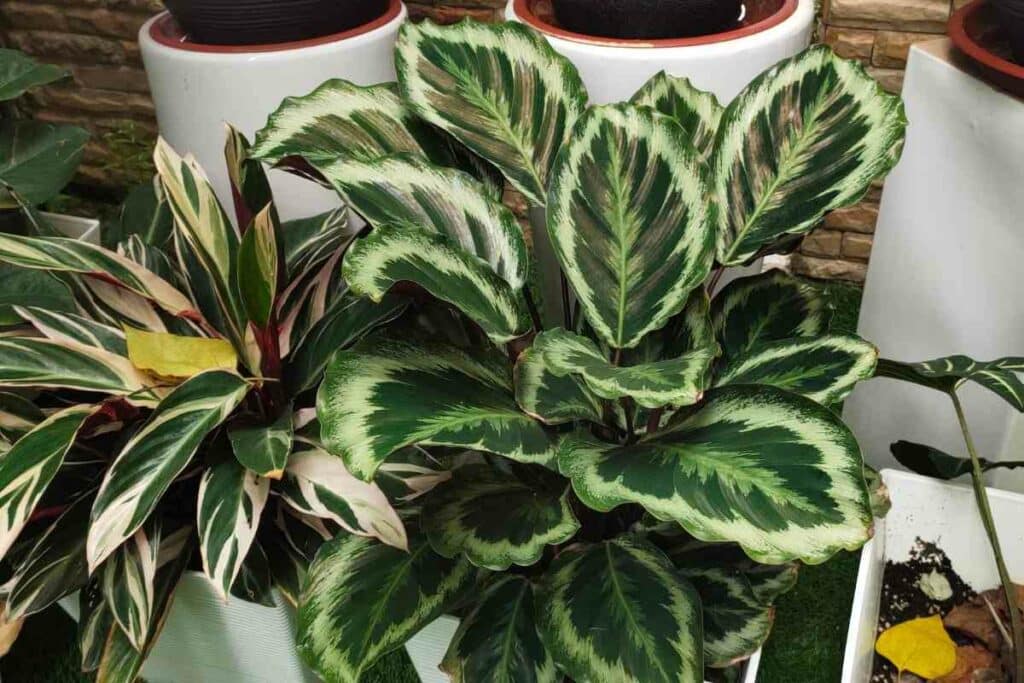
A good way of knowing whether or not the space is bright enough is to read there. Being able to read there comfortably will mean it is a bright enough place.
If the leaves are in direct sunlight, they will develop bleached spots or brown tips.
You should ensure that the place isn’t too dark.
Heads Up! If your plant doesn’t get enough light, it won’t have as many leaves and the colors won’t be as vivid. It also won’t grow very big.
Warmth
A peacock plant is great for the home because they like to feel as warm as we do.
A peacock plant likes the temperature to be between 60 °F and 75 °F.
Even if you have your room within that range, it’s important there are no sudden changes.
What’s more, if you have vents, air conditioning, or an oven nearby, this will likely cause a sudden change in humidity or temperature that won’t be good for the plant.
Humidity
Peacock plants like a humid place. It’s important to consider the humidity, especially in winter when the heating can dry out the air in your home.
A peacock plant needs a humidity of 60% or above.
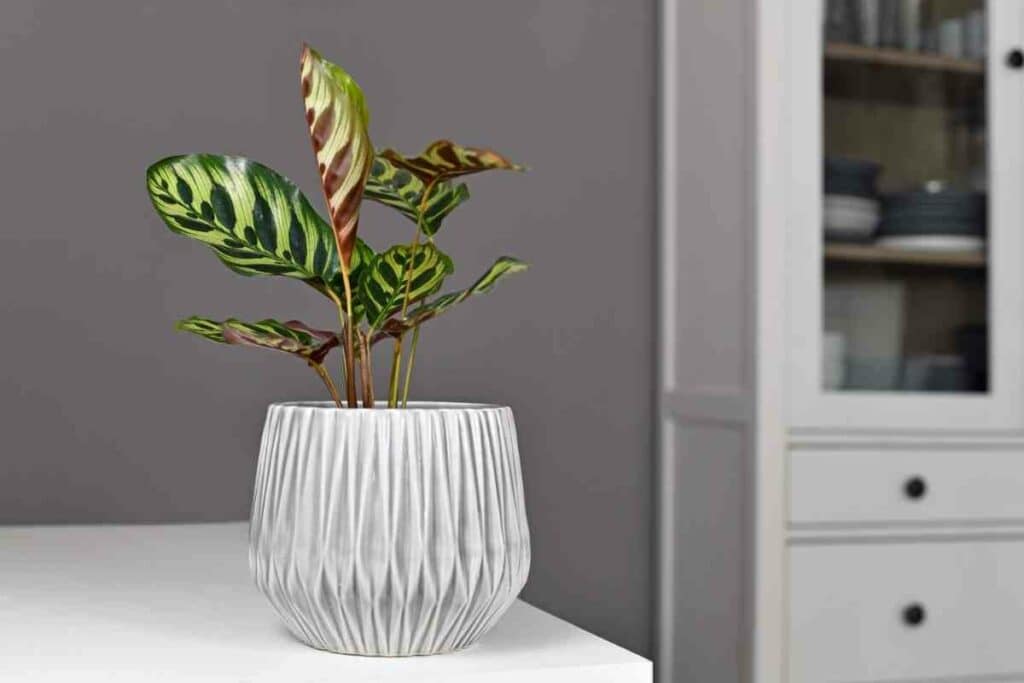
You can use a hygrometer to measure your home’s humidity. If you need to increase it, you can use a spray to mist the plant.
You can also place it with other plants.
If your home generally has low humidity, keeping the plant in your kitchen or bathroom is a good idea as these places are the most humid.
An airy and lightweight potting mix
To prevent the roots from rotting while keeping moisture in the soil, it’s essential to use a soil mix that works well.
If you need to improve the drainage, you can add fine gravel, orchid bark, pumice, or perlite to the soil.
Compost and peat moss will provide enough nutrients too.
If you choose to use orchid back, be aware that it will decompose eventually and will need replacing. It’s important to check the soil acidity as these plants need soil that is slightly acidic.
Fertilize every month
During spring and summer, you will need to feed your peacock plant with a general fertilizer once a month.
In Winter – The plant grows less and so won’t need any extra energy.
You should choose a liquid fertilizer that is well-balanced. It should have equal parts potassium, phosphorus and nitrogen.
These plants, like other Calatheas, are very sensitive to any sort of synthetic fertilizer. This is because the high salt levels can cause root damage.
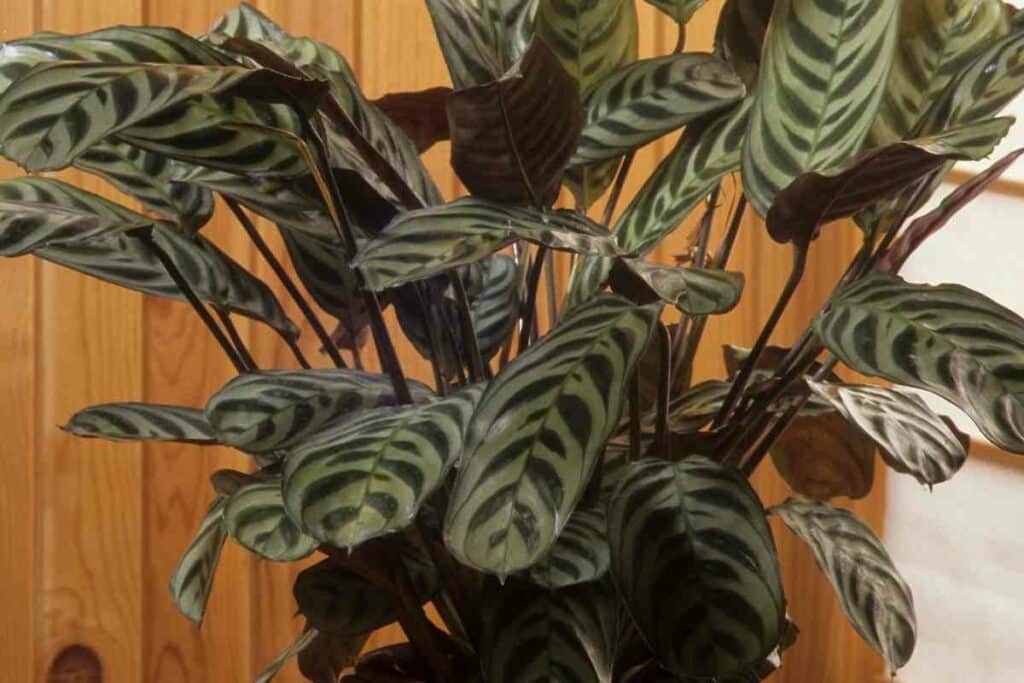
With this in mind, you should water your plant 24 hours before using a fertilizer.
This will mean the roots won’t be shocked or burnt by the nutrients. If you notice the leaf tips turning brown, it could mean you are over-fertilizing the plant.
Watering requirements
A peacock plant needs moist soil, but it should never sit in water.
It’s quite common for tropical plants in pots to have root rot caused by overwatering. This happens when the roots are in a soggy soil.
Once root rot sets in, it’s difficult to fix. It’s better to water cautiously because of this.
Watering twice a week is enough – and wait until the soil surface feels dry before you do so.
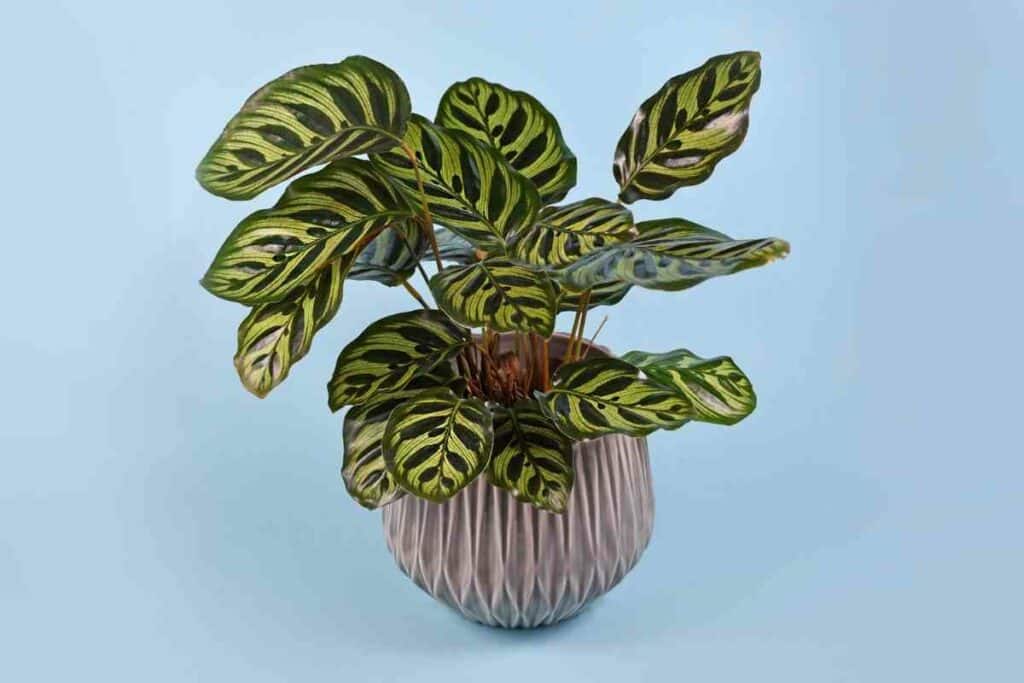
The soil should drain well. You should water your plant in the sink until you notice water draining out of the drainage holes.
Then, when the dripping has stopped, the soil will be moist enough.
If the pot is only letting a few drops out and getting heavy, you will need to add more drainage holes or mix perlite to your soil matter.
The type of water
These plants are sensitive, and as tap water contains minerals and fluoride, you might be inadvertently causing damage or discoloration to your plant and its leaves.
For the Best Results – Use filtered or distilled water. You could also collect rainwater. If tap water is your only option, pour it in a glass and let it sit for a few days so that the minerals will dissipate prior to watering.
Pruning a peacock plant
You’ll find that you don’t need to prune your peacock plant much but when you do, it’s not difficult.
The most important thing to remember is not to prune it after you’ve just re-potted it due to it already being stressed.
When you do want to prune it, simply snip any damaged or browning leaves off at the stem. You should class any leaves with pests or disease as damaged.
All pruned leaves should be disposed of because if you leave them on the soil, they can cause disease.
Diseases and pests
Peacock plants are pretty hardy against pests like spider mites and aphids.
If you do get pests or disease, the first signs will be discoloration to the leaves and undersides.
Aphids tend to go onto the plant to suck out its sap. You can remove these quite easily with a water and garlic solution or simply by wiping them with a cloth.

Spider mites, though tiny, can suck out the nutrients.
You’ll notice small webs near the plant. If there are too many of them, they can cause lots of damage. With spider mites, neem oil can be used. It’s also good for scale.
A common disease for peacock plants is pseudomonas leaf spot. This is caused by a bacterium that thrives on moist leaves.
The disease causes spots on the leaves and leaf distortion.
To Treat This Problem – You need to remove any affected leaves and apply a solution of water and baking soda.
FAQs
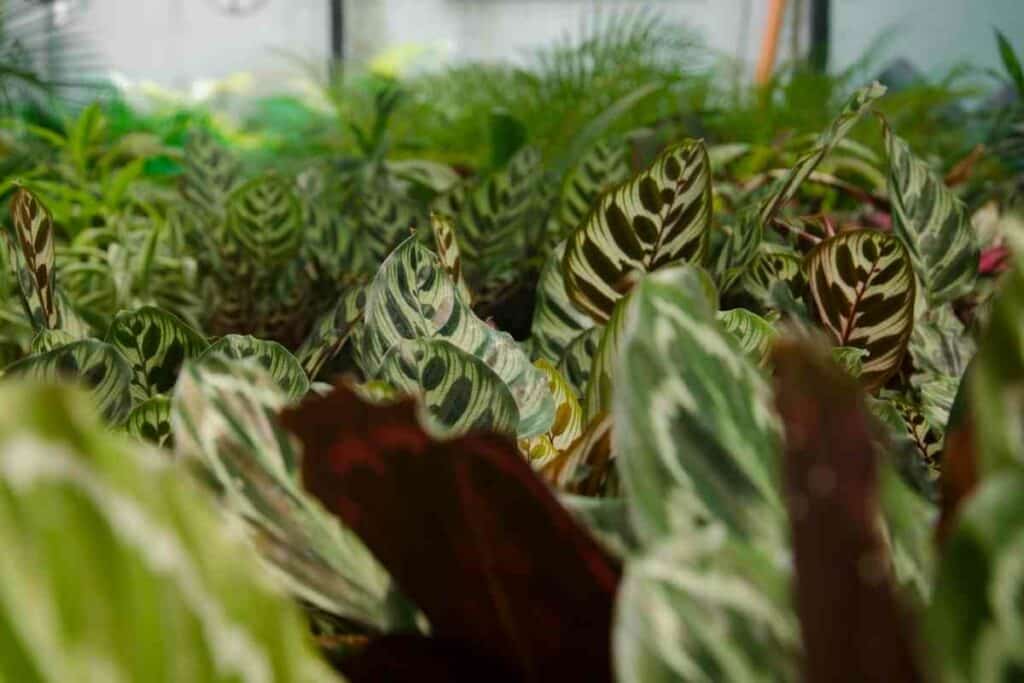
How do you keep a peacock plant in a humid space without a humidifier?
Many people choose to keep a peacock plant in their kitchen or bathroom.
This is because cooking and showering raises the humidity levels. If the lighting allows, you could even keep the plant inside the shower where it can be misted daily.
If you have more than one tropical indoor plant, you can keep them all together with a tray of pebbles and water close by. This will increase the humidity.
Putting plastic sheeting surrounding the plant also creates a mini greenhouse effect too!
What do you do if your peacock plant’s leaves turn brown?
Not enough water or poor humidity are often the two main reasons why you might see the tips of your plant’s leaves go brown.
It could be that you need to water your plant more frequently or put it in a better place.
If you want to check whether or not your plant needs more water, you can put your finger into the soil up to your first knuckle. If your finger is dry, you can assume your plant needs more water.
Browning can also occur due to a plant needing more light.
If you’ve eliminated both of these things, you could try changing your water to filtered or distilled and hold off fertilizing for a month or two.
What causes a peacock plant’s leaves to curl?
The first cause of curling is usually that there isn’t enough moisture in the soil.
You should give your plant a good drink while allowing excess water to drain out.
Your plant’s leaves might also curl due to the temperatures being too cool so try increasing the temperature of the room to see if that makes a difference.
When does a peacock plant need repotting?
These plants don’t take well to unnecessary repotting.
It’s perfectly fine to repot your plant every couple of years unless you have some sort of huge pest problem that needs resolving.
When you do repot your plant, you should add more peat moss and organic matter into the soil.
You’ll also need to improve its drainage again by adding perlite or orchid bark. Choose to do any repotting in springtime when it’s easier for your plant to bounce back.
What size of pot does a peacock plant need?
If you have a newly propagated peacock plant, you should use a small pot.
When the plant starts to get root-bound, you know it’s time for a new pot. Mature peacock plants are fine in a pot with a diameter of 8 to 10 inches.
What type of pot is best?
A plastic pot inside a ceramic pot is arguably the best type of pot for a peacock plant.
This is because ceramic and terracotta pots on their own are porous and will absorb moisture from the soil making it dry out more quickly.
Final Thoughts
The Peacock plant is one of my favorite indoor plants.
The red portion of the leaves always looks so good on my window ledge in the sun.
Relatively easy to take care of as well, which is always a bonus.
Calathea Ornata Sanderiana is one of my favorite varieties and always reminds me of Zebras I saw whilst on a Safari holiday in South Africa.
I hope this simple care guide helps you enjoy and care for your Peacock plant a little more and get the most out of growing them in your own home.


